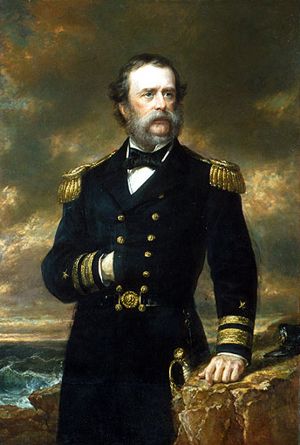
Library of Congress.
Rear Admiral Samuel Francis du Pont by Daniel Huntington.
In the Mexican War, he commanded Cyane, which captured or destroyed thirty enemy ships in the Pacific. He then worked toward modernizing the US Navy and served briefly as Superintendent of the Naval Academy. An advocate of mobile offense, he participated in making plans to blockade the Atlantic seaboard when the Civil War broke out in April 1861.
Du Pont was appointed flag officer in September and placed in command of the US Navy’s largest force assembled to that time. On 7 November, he achieved an important victory against fortifications at Port Royal, South Carolina, which led to the seizure of sounds and waterways and the establishment of blockading stations between Savannah, Georgia and central Florida. For this, he received the thanks of Congress and on 18 July 1862 was promoted to rear admiral.
Although du Pont believed Charleston could not be taken by a naval assault alone, he assumed command of nine monitors and attempted to force passage on 7 April 1863. Repulsed, he decided not to renew the assault and on 6 July was relieved by Rear Admiral Dahlgren.
Rear Admiral du Pont died on 23 June 1865 while on a trip to Philadelphia. He is buried in the du Pont family cemetery at Greenville, Delaware.
In 1882, Congress commissioned a memorial statue, which was unveiled in 1884 at what is now Du Pont Circle. It was replaced in 1921 with a marble fountain.